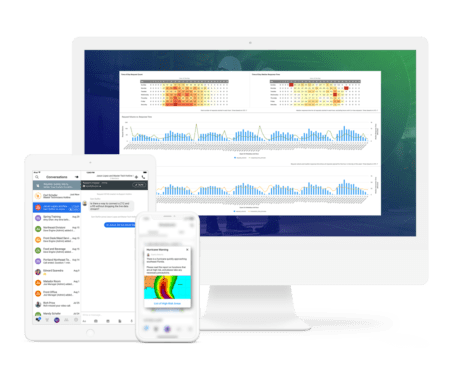Today, corporate messaging apps have become a necessary part of an effective communication strategy. Great messaging apps enhance organizational communication and team productivity, allowing dispersed employees to communicate and collaborate in real time. But the prevalence of not-so-great apps has led to WhatsApp being the most widely-used communication app in the workplace.
To help combat consumer app usage, we’ve put together a list of the top five corporate messaging apps so you can evaluate the different features and determine which best fits your business.
1. Microsoft Teams – Group Chat
Microsoft Teams is a shared workspace that allows users to chat, hold audio and video calls, collaborate on files, and work with other 3rd-party apps. Microsoft Teams supports internal communication but does not support access for anyone outside of the organization, such as customers, contractors or vendors.
Microsoft Teams is included with an Office 365 Business Premium subscription or Office 365 Business Essentials subscription. There is also a free version that has limited chat features, security and compliance, and no admin capabilities or support.
Why You’d Choose: Microsoft Teams is a good choice for companies who already pay for an Office 365 Premium or Essentials subscription, and have a workforce who primarily works from desktop computers in an office.
Why You Wouldn’t Choose: For companies who have mobile teams, such as field service technicians, hospitality staff and utility crews, this app proves too cumbersome. These frontline workers require a familiar, intuitive interface that easily connects them with the right people, information and resources. Additionally, employees who need to collaborate with people outside their organization will not be able to do so in Teams.

Corporate Messaging Apps: Microsoft Teams
2. Zinc – Real-Time Communication
Zinc Real-Time Communication is an app from ServiceMax built specifically for field service teams. Zinc supports messaging, audio and video calls, content sharing, location sharing, push to talk and broadcasts on both mobile and desktop apps. Powerful group messaging capabilities allow users to easily collaborate, share tribal knowledge, and get questions answered immediately. Robust administrative features ensure Zinc is configured to meet your organization’s needs, and communication analytics provide insight into how employees communicate. With integrations into common field service solutions, Zinc easily folds into existing workflows. Zinc is available on a per user per month subscription.
Why You’d Choose: Zinc is a good choice for any company with a technically skilled mobile workforce whose efficiency and productivity directly impact customer satisfaction. Because Zinc combines all modes of communication into one easy app, deskless workers have a one-stop-shop for all their work communication needs, plus special features like Hotline Groups and Broadcasts that cater to their unique use cases.
Why You Wouldn’t Choose: Zinc is built for frontline workers, such as cable technicians and utility crews, resulting in innovative features and integrations that meet the unique needs of this workforce. If your company is solely made of desk workers, you’ll find a lack of integrations built to meet their needs.

Corporate Messaging Apps: Zinc
3. Crew – Messaging and Scheduling
Crew is a communications app built for shift-based workers, such as coffee shop, fast food, retail and supermarket workers. Crew supports messaging, announcements, scheduling, shift management, task management, and gold stars. Crew offers a limited free version, as well as 3 tiers of business subscriptions.
Why You’d Choose: Crew has found a niche with shift-based customer service teams. If you are looking for a simple messaging solution that doesn’t distract employees and keeps them engaged, on-task and accountable, Crew is a good choice.
Why You Wouldn’t Choose: Like Zinc, Crew is building features for a unique part of the workforce that currently doesn’t have much in the way of communication technology. If your employees aren’t a shift-based service team, another solution will better support your use cases. Additionally, if you are looking for a more robust communication platform that has more than just chat and scheduling features (such as calling, video chat, analytics or push to talk), Crew will not suffice.

Corporate Messaging Apps: Crew
4. Workplace by Facebook – Work Collaboration
Workplace by Facebook builds upon a user experience most employees are familiar with and adds in additional features for work communication. In Workplace, you can add employees to Teams and Projects where members are able to write posts, take polls, and share files, photos, and videos. Workplace also supports announcements, open discussions, and social groups. In addition to messaging in Workplace Chat, employees can also make audio and video calls. Workplace offers a free version that lacks enterprise features such as administration, security and support, as well as a Premium per user per month subscription.
Why You’d Choose: Companies who struggle with keeping employees engaged and informed on corporate news and information, especially after hours, will find that Workplace is a good solution. Rather than emailing company news, events and HR information, you can post these updates to Workplace and see how engaged employees are through likes and comments.
Why You Wouldn’t Choose: Companies who are looking for true real-time team collaboration and communication on the job will find that Workplace doesn’t deliver. Rather than a holistic place where employees can ask questions and collaborate in real time, Workplace offers multiple fragmented streams of communication in the form of News Feeds that are hard to keep up with and don’t encourage immediate responses. Conversations become more like email threads than actual live back and forths. Additionally, Workplace has limited integrations into other enterprise tools.

Corporate Messaging Apps: Workplace
5. Slack – Team Chat
Slack is a leading team chat app that makes its mark with an impressive array of enterprise integrations and a reputation for being highly addictive (whether that’s for better or worse). Via Slack channels and direct messages, teams can message, share files, hold audio and video calls and search conversation histories. The Slack App Directory contains over 100 apps in addition to Slack APIs that allow you to integrate complex services with Slack that aren’t available out of the box. Slack offers a free version with limited message storage and no administration, as well as per user per month subscriptions.
Why You’d Choose: For employees who work beside a computer all day, Slack is a great tool for constant communication.
Why You Wouldn’t Choose: For mobile employees who need immediate access to answers, information, and experts while on the job, Slack is not a great option. The feed-based experience of Slack is most effective when a user is checking it 24/7 to stay up-to-date. When you have employees who are working directly with customers or driving to a job site, the last thing you want is them sorting through a feed of channels to get answers. In addition, deskless teams have found Slack’s interface too convoluted and rather than adopt Slack, they resort back to consumer-based real-time messaging solutions like WhatsApp.

Corporate Messaging Apps: Slack
Wrap Up – The Best Corporate Messaging Apps
Hopefully, this rundown of the best business messaging apps helps you narrow down which solutions will work best for your team. If Zinc sounds like it would be a great fit, feel free to schedule a demo here.


Share this: